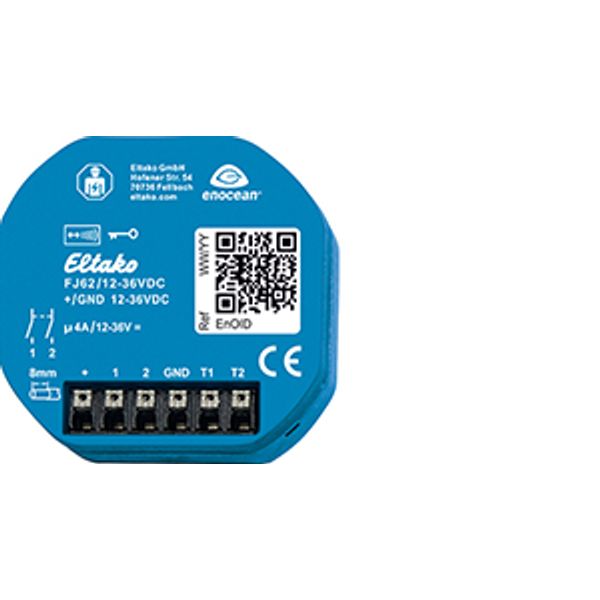Livraison gratuite à partir de 5000 EUR! Notre entrepôt est prêt à stocker vos commandes jusqu'à ce que le montant requis soit atteint
Wireless shading element and roller shutter actuator
En stock: Non
Stock fournisseur: Non
Quantité minimale de commande: 1
Prix (hors TVA):
48,35 €
EAN: 4010312319406
MPN: 30200540
Colis: 1
Technical Information
| État de l’article | Nouveau |
| Nom du fabricant | Wireless shading element and roller shutter actuator |
| Marque | ELTAKO |
| Catégories |
Interrupteurs |
| Pays d’origine | CN |
| Code du système harmonisé | 8526 9200 00 |
| Méthode de montage | Montage encastré (plâtre) |
| Couleur | Bleu |
| Sans halogène | Yes |
| Protection de surface | Autre |
| Alimentation en courant | Autre |
| Nombre de relais | 2 |
| Adapté à l'interrupteur | Yes |
| Adapté au bouton d'impulsion | Yes |
| Convient pour variateur d'intensité | No |
| Adapté à l'interrupteur de volet roulant | Yes |
| Qualité des matériaux | Thermoplastique |
| Matériau | Plastique |
| Type de fixation | Autre |
| Système de code déroulant | Yes |
| Nombre de commandes | 32 |
| Fréquence radio | 868 MHz |
| Dans le boîtier | Yes |
| Dans le boîtier de base du tube | No |
| Carte de circuit imprimé/module | No |
| Mode bouton-poussoir | Yes |
| Mode de commutation | Yes |
| Avec émetteur radio manuel | No |
| Avec dispositif de codage radio | No |
| Avec bouton-poussoir radiocommandé | No |
| Adapté à l'interrupteur de volet vénitien/roulant | Yes |
| Adapté à un interrupteur de volet vénitien | Yes |
| Transparent | No |
| Finition de la surface | Mat |
| Adapté au degré de protection (IP) | IP20 |
| Prise en charge IFTTT disponible | No |
| Compatible avec Apple HomeKit | No |
| Compatible avec Google Assistant | No |
| Compatible avec Amazon Alexa | No |
Détails d’emballage
| Niveau d’emballage 1 | 4010312319406, 4010312319406 |
| Niveau d’emballage 2 | 4010312319406 |
| Niveau d’emballage 3 | 4010312319406 |
Téléchargements
Description
Wireless shading element and roller shutter actuator 1+1 NO contact, 4A/36V DC, not potential free, for a shading element motor 12-36V DC. Standby loss only 0.3-0.5 watt. For installation. 49x51mm wide, 20mm deep. The terminals are plug-in terminals for conductor cross-sections of 0.2mm2 to 2.5mm2. The convenient tap technology permits the teach-in of up to 32 wireless universal pushbuttons, wireless direction pushbuttons and wireless central control pushbuttons. Bidirectional wireless switchable. Supply voltage, switching voltage and control voltage local 12-36V DC. If supply voltage fails, the device is switched off in defined mode. In addition to the wireless control input via an internal antenna, this wireless actuator can also be controlled locally by a conventional control switch if fitted previously. Control is either by separate local control inputs for Up and Down as direction pushbuttons or these two inputs are bridged and controlled by single pushbuttons as universal pushbuttons. A change in direction then takes place by interrupting activation. An incandescent lamp current is not permitted. Wireless pushbuttons can be taught in with either the functions Up-Stop-Down-Stop as universal pushbuttons or as local pushbuttons as well as a wireless pushbutton or roller shutter double pushbuttons can be taught in as direction pushbuttons with press top for Up and bottom for Down. Press briefly to stop the movement. In addition, the central control button can be taught in with static priority. The static priority is only active as long as the radio button is pressed. With a control signal, e.g. B. a radio transmitter module FSM61 with switches that has been taught-in as a central control button, the switching position Up or Down and the priority are specifically activated. With priority because these control signals cannot be overridden by other control signals until the central command is canceled again by the end of the control signal. The tap reverse function can be activated: universal pushbuttons, direction pushbuttons and wired pushbuttons are intially in static mode so that the position of the blind can be adjusted. Switched to dynamic only after activation > 1 second. With control via Professional Smart Home controller, operating commands for up and down with the exact travel time information can be started. As the actuator reports the exact elapsed time after each activity, even when driving was triggered by a pushbutton, the position of the shading is always displayed correctly in the Professional Smart Home controller. Upon reaching the end positions above and below the position is automatically synchronized. When a wireless window contact is taught in, a lockout protection is set up for open windows or doors to disable the Central Down and controller Down commands.

